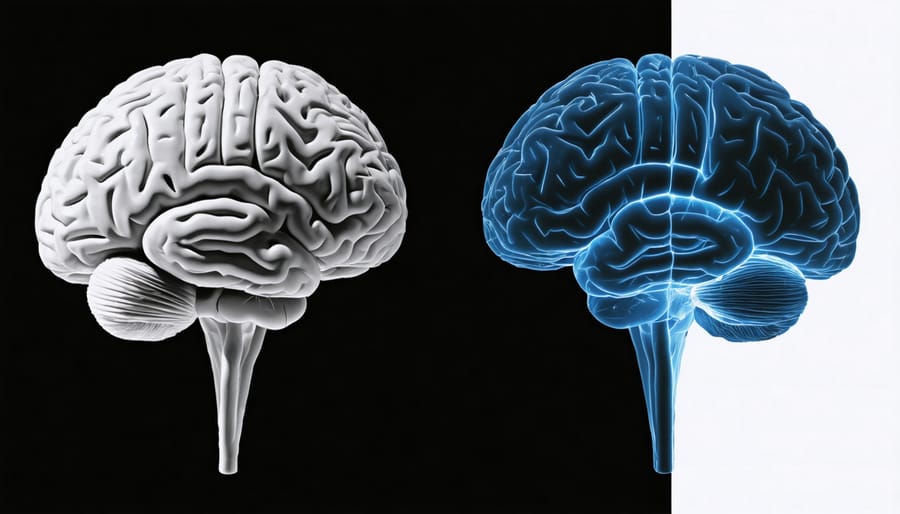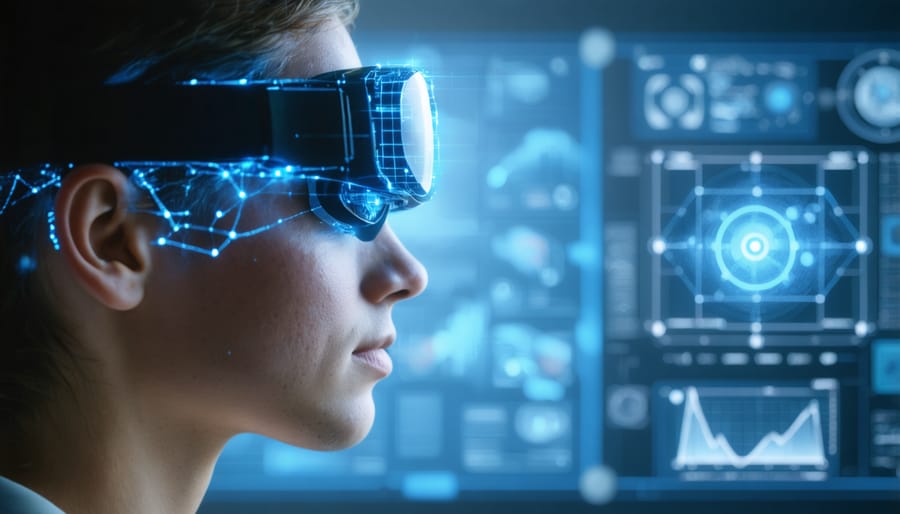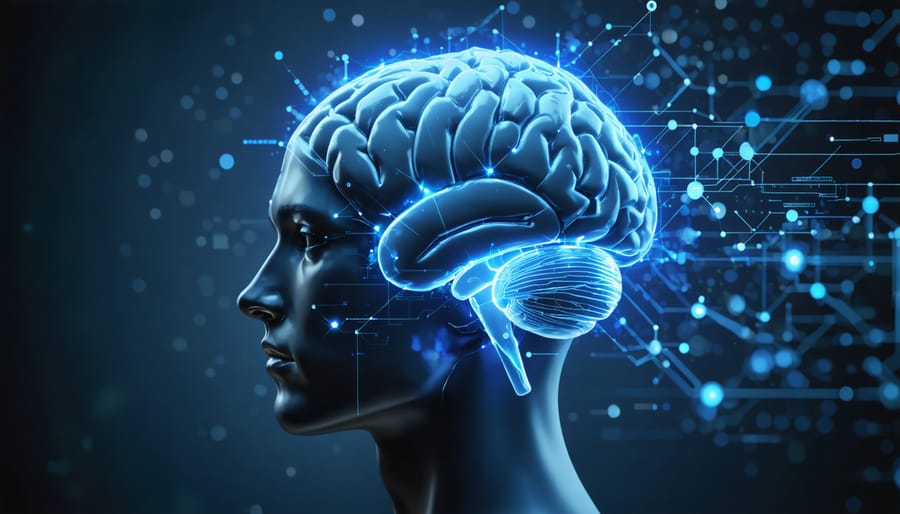At the intersection of artificial intelligence and neuroscience lies a revolutionary frontier that’s rapidly transforming our understanding of the human brain. By combining advanced machine learning algorithms with neurological research, scientists are decoding neural patterns, predicting brain responses, and developing breakthrough treatments for neurological disorders with unprecedented precision. This convergence of cognitive science and AI integration has opened new possibilities in brain-computer interfaces, enabling direct communication between human thought and digital systems.
Recent breakthroughs in deep learning architectures have made it possible to analyze vast amounts of neurological data in ways that were impossible just a decade ago. From mapping neural networks in real-time to predicting cognitive responses before they occur, AI is revolutionizing how we study, understand, and interact with the most complex organ in the human body. As these technologies continue to evolve, they promise to unlock new treatments for conditions like Alzheimer’s, depression, and paralysis, while advancing our fundamental knowledge of consciousness and cognition.
How AI is Transforming Neuroscience Research
Neural Network Analysis of Brain Activity
Neural networks have revolutionized how we analyze and understand brain activity by processing vast amounts of complex neural data in ways that weren’t possible before. These AI systems work similarly to the human brain, using layers of interconnected nodes to identify patterns and make sense of neural signals.
When analyzing brain activity, neural networks process data from various sources, including EEG readings, fMRI scans, and direct neural recordings. The AI system breaks down these inputs into manageable pieces, looking for specific patterns and correlations that might be invisible to the human eye. For example, when studying epilepsy, neural networks can detect subtle changes in brain wave patterns that often precede seizures.
These systems excel at handling the brain’s complexity because they can process multiple data streams simultaneously. While a human researcher might struggle to analyze thousands of neurons firing at once, AI can track these patterns in real-time and identify meaningful relationships between different brain regions.
One particularly exciting application is in brain-computer interfaces, where neural networks decode brain signals into actionable commands. This technology helps researchers understand how thoughts translate into actions and has practical applications in helping paralyzed individuals control prosthetic limbs or communicate through computers.
The analysis process typically involves three main steps: signal preprocessing to clean the data, feature extraction to identify important patterns, and classification to categorize different types of brain activity. This systematic approach allows researchers to make breakthrough discoveries about how our brains function and respond to various stimuli.

Machine Learning in Brain Mapping
Machine learning has transformed how scientists map and understand the human brain, creating more detailed and accurate representations than ever before. By processing vast amounts of neuroimaging data, AI algorithms can identify patterns and connections that would be impossible for humans to detect manually, similar to how AI is revolutionizing healthcare applications.
Modern brain mapping techniques powered by AI can process multiple types of brain scans simultaneously, including MRI, fMRI, and EEG data. This multi-modal approach provides a more comprehensive view of brain structure and function. For example, deep learning algorithms can analyze thousands of brain scans to create detailed 3D maps of neural pathways, helping researchers understand how different brain regions communicate.
One of the most significant advantages of AI-powered brain mapping is its ability to detect subtle variations in brain structure and activity that might indicate neurological conditions before traditional diagnostic methods can spot them. These systems can track changes over time, making them valuable tools for monitoring disease progression and treatment effectiveness.
AI also helps standardize brain mapping across different research facilities, creating a common framework for scientists worldwide to share and compare their findings. This collaborative approach accelerates our understanding of the brain and supports the development of new treatments for neurological conditions.

Brain-Computer Interfaces: The AI Connection
Real-time Neural Signal Processing
Real-time neural signal processing represents one of the most exciting frontiers in AI-powered medical analysis, particularly in brain-computer interfaces (BCIs). These systems capture brain signals and translate them into actionable commands within milliseconds, enabling direct communication between the brain and external devices.
Modern AI algorithms, especially deep learning models, excel at filtering out noise from neural signals and identifying meaningful patterns in brain activity. This process happens in three key stages: signal acquisition, where electrodes capture brain activity; feature extraction, where AI identifies important signal characteristics; and classification, where these features are interpreted into specific commands or intentions.
What makes this technology particularly revolutionary is its ability to adapt and learn from each user’s unique brain patterns. Through continuous feedback loops, the AI system becomes more accurate over time, improving its interpretation of neural signals. This adaptability is crucial for patients using BCIs for mobility assistance or communication devices.
The processing speed is remarkable – modern systems can analyze neural signals and generate responses in less than 100 milliseconds, creating an experience that feels natural and responsive to the user. This rapid processing is essential for applications like controlling prosthetic limbs or operating assistive devices, where even slight delays could impact usability.

Adaptive Learning in BCIs
One of the most fascinating aspects of modern brain-computer interfaces (BCIs) is their ability to learn and adapt to each user’s unique brain patterns. Unlike traditional one-size-fits-all systems, adaptive BCIs use machine learning algorithms to continuously refine their understanding of individual neural signals.
Think of it like learning a new language with a personalized tutor. Initially, the BCI system observes and learns the basic “vocabulary” of your brain signals. As you interact with the system, it picks up on subtle variations in your neural patterns, much like recognizing different accents or speaking styles.
These adaptive systems employ sophisticated AI algorithms that can distinguish between intentional commands and background neural noise. For example, when a user thinks about moving a prosthetic arm, the system learns to recognize not just the general pattern for “move arm,” but the specific way that user’s brain represents that command.
What makes this technology particularly powerful is its ability to adjust to changes over time. Our brains naturally fluctuate day to day, and neural patterns can shift due to factors like fatigue, mood, or learning. Adaptive BCIs compensate for these changes automatically, maintaining consistent performance even as the user’s brain signals evolve.
This personalized approach has dramatically improved the usability of BCIs, making them more reliable and intuitive for users while reducing the initial training time needed to operate these devices effectively.
Current Applications and Future Potential
AI in neuroscience has already made significant strides in real-world applications, particularly in medical diagnosis and treatment. Brain-computer interfaces (BCIs) now enable paralyzed individuals to control robotic limbs through thought alone, while AI-powered systems help detect early signs of neurological conditions like Alzheimer’s and Parkinson’s disease.
In clinical settings, machine learning algorithms analyze brain scans to identify tumors and predict stroke outcomes with increasing accuracy. These tools assist healthcare providers in making faster, more precise diagnoses and developing personalized treatment plans.
Looking ahead, researchers are exploring even more ambitious applications. Neural decoding technologies are advancing rapidly, potentially allowing direct communication between the human brain and external devices. This could revolutionize how we interact with computers and help restore function to individuals with severe neurological injuries.
The future also holds promise for AI-enhanced brain mapping projects, which could create detailed atlases of neural connections and help us better understand consciousness and cognitive processes. Scientists are working on AI systems that could help treat mental health conditions by identifying patterns in brain activity and suggesting targeted interventions.
While these developments are exciting, they also raise important ethical considerations about privacy, consent, and the boundaries between human cognition and artificial intelligence. As technology continues to evolve, striking the right balance between innovation and responsible implementation remains crucial.
Challenges and Ethical Considerations
Technical Limitations
While AI has made remarkable strides in neuroscience research, several significant limitations still pose challenges for researchers and developers. One of the primary hurdles is the sheer complexity of neural data processing, which leads to substantial computational challenges and energy requirements. The human brain contains approximately 86 billion neurons with trillions of connections, making it difficult for current AI systems to process and analyze this vast network effectively.
Data quality and standardization remain persistent issues, as brain imaging techniques often produce noisy or incomplete datasets. This can lead to unreliable AI model predictions and interpretations. Additionally, the variability between individual brains makes it challenging to develop universal AI solutions that work consistently across different subjects.
The “black box” nature of many AI algorithms also presents a significant limitation, particularly in medical applications where transparency and interpretability are crucial. Researchers often struggle to explain exactly how AI systems arrive at their conclusions about neural patterns or predictions.
Ethical considerations also impose constraints on data collection and experimentation. Privacy concerns, informed consent requirements, and the need for careful validation of AI-driven interventions can slow down research progress and limit the scope of potential applications in clinical settings.
Ethical Framework
As AI continues to revolutionize neuroscience research, ethical considerations have become increasingly important. The intersection of artificial intelligence and brain research raises significant questions about privacy, consent, and the responsible use of sensitive neural data.
One primary concern is data protection. Brain scans and neural recordings contain highly personal information that could reveal thoughts, emotions, and even memories. Researchers must implement robust security measures to protect this sensitive data from breaches or misuse. Additionally, there’s the challenge of obtaining informed consent when AI systems might discover unintended or unexpected patterns in neural data.
The potential for AI bias in neuroscience applications is another critical consideration. If AI models are trained on limited or non-diverse datasets, they might produce results that don’t accurately represent all populations, leading to potential disparities in diagnosis and treatment.
There’s also the question of autonomy and human agency. As brain-computer interfaces become more sophisticated, we must carefully consider the balance between technological assistance and maintaining individual control over our thoughts and actions.
The scientific community has responded by developing ethical guidelines for AI in neuroscience. These include principles for responsible data collection, transparent reporting of AI methods, and clear boundaries for human-AI interaction in brain research. Regular ethical reviews and stakeholder engagement help ensure that advances in this field benefit society while protecting individual rights and dignity.
The convergence of AI and neuroscience has opened up extraordinary possibilities in our understanding of the human brain and its functions. Throughout this exploration, we’ve seen how machine learning algorithms are revolutionizing brain mapping, enhancing diagnostic accuracy, and advancing neural interface technologies. These developments are not just theoretical achievements but are already making tangible impacts in clinical settings and research laboratories worldwide.
As we look to the future, the potential for AI in neuroscience appears boundless. Emerging technologies like deep learning networks that mimic neural pathways are providing new insights into consciousness and cognitive processes. Meanwhile, advances in brain-computer interfaces are bringing us closer to effective treatments for neurological conditions and enhanced human-machine interaction.
However, this rapid progress also brings important considerations. Ethical implications, data privacy concerns, and the need for transparent AI systems must remain at the forefront of future developments. The field requires continued collaboration between neuroscientists, AI researchers, and healthcare professionals to ensure responsible advancement.
The next decade will likely see even more dramatic breakthroughs, from more sophisticated brain mapping techniques to revolutionary therapeutic approaches for neurological disorders. As AI technologies become more refined and our understanding of the brain deepens, we can expect to see increasingly practical applications that benefit both medical practice and scientific research. This exciting intersection of AI and neuroscience continues to push the boundaries of what’s possible in human brain understanding and enhancement.

